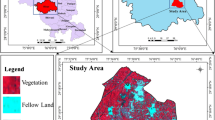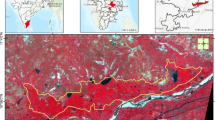Abstract
In the arid region of Rajasthan, India, it is very often a challenge to store rain/surface water for year-round use by human and livestock. The inhabitants of this desert area have developed several water storage structures, which they used to construct based on their indigenous knowledge of local terrain conditions. Recently, farmers living in the lower command areas of Indira Gandhi canal have constructed micro-farm water storage structures, called diggi, in their cropland. They store allocated canal water in diggi to timely utilize it as per irrigation requirements, and thus, done away with problems of deficit and untimely canal water supply. This impact assessment study, carried out in Poogal tehsil of Bikaner district, analyzed high-resolution satellite images for 2 years and used a geographic information system to quantify diggi structures and studied the diggi-growth interactions with changing rainfall pattern as well as land use/land cover. Results showed that during 2018, about 3243 number of structures were constructed compared to 241 existed during 2004–2005. The mean annual rainfall increased by 30% and crop area by 12,772 ha during the same period that included 7.86% increase in irrigated and 2.98% in rainfed croplands. Thus, diggi-based water management has been immensely helpful in the perspective of irrigated agriculture in the desert region.









Similar content being viewed by others
References
Amarasinghe UA, Bhaduri A, Singh OP, Ojha A, Anand BK (2008) Cost and benefits of intermediate water storage structures: Case study of diggies in Rajasthan. In: Kumar MD (ed), Managing water in the face of growing scarcity, inequity and declining returns: exploring fresh approaches. Proceedings of the 7th Annual Partners Meet, IWMI TATA Water Policy Research Program, ICRISAT, Patancheru, Hyderabad, India, 2–4 April 2008. Vol. 1. Hyderabad, India: International Water Management Institute (IWMI), South Asia Sub Regional Office. pp. 51–66
Bhat TA (2014) An analysis of water demand and supply in India. J Environ Earth Sci 4(11):67–72
Goyal RK, Vittal KPR (2008) Water resources management in hot arid zone of India. J Hydrol Res Dev 23:37–54
Goyal RK, Angchok D, Stobdan T, Singh SB, Kumar H (2009) Surface and groundwater resources of arid zone of India: assessment and management. In: Kar A, Garg BK, Singh MP, Kathju S (eds) Trends in arid zone research in India. Central Arid Zone Research Institute, Jodhpur, pp 113–150
Goyal RK, Singh JP, Gaur MK (2018) Khadin system of runoff farming for crop production. Indian Farming 68(09):26–28
Goyal RK, Moharana PC, Gaur MK (2019) Diggies-micro conservation structures in desert region of Rajasthan. CAZRI News, 9(2) April-June, 2019. pp. 5–6
Hussain J, Husain I, Arif M (2014) Water resources management: traditional technology and communities as part of the solution. In: Evolving water resources systems: understanding, predicting and managing water-society interactions. Proceedings of ICWRS2014, Bologna, Italy, June 2014 (IAHS Publ. 364, 2014), pp. 236–242
Kar A (2014) Agricultural land use in arid Western Rajasthan: resource exploitation and emerging issues. Agropedology 24(2):179–196
Kendall MG (1975) Rank correlation methods. Charles Griffin and Co., Ltd., London, UK
Kharol SK, Kaskaoutis DG, Badarinath KVS, Sharma AR, Singh RP (2013) Influence of land use/land cover (LULC) changes on atmospheric dynamics over the arid region of Rajasthan state, India. J Arid Environ 88:90–101
Kumar S, Ramilan T, Ramarao CA, Srinivasa Rao C, Whitbread A (2016) Farm level rainwater harvesting across different agro climatic region of India: assessing performance and its determinants. Agric Water Manag 176:55–66
Machiwal D, Jha MK (2012) Hydrologic time series analysis: theory and practice. Springer, New Delhi
Machiwal D, Jha MK (2017) Evaluating persistence, and identifying trends and abrupt changes in monthly and annual rainfalls of a semi-arid region in western India. Theoret Appl Climatol 128(3–4):689–708
Machiwal D, Kumar S, Dayal D (2016) Characterizing rainfall of hot arid region by using time series modeling and sustainability approaches: a case study from Gujarat, India. Theoret Appl Climatol 124:593–607
Machiwal D, Gupta A, Jha MK, Kamble T (2019) Analysis of trend in temperature and rainfall time series of an Indian arid region: comparative evaluation of salient techniques. Theoret Appl Climatol 136(1–2):301–320
Machiwal D, Parmar BS, Kumar S, Meena HM, Deora BS (2021) Evaluating homogeneity of monsoon rainfall in Saraswati river basin of Gujarat, India. J Earth Syst Sci 130:181
Malhotra SP (1982) The warabandi and its infrastructure. Central Board of Irrigation and Power, Government of India, New Delhi
Mann HB (1945) Non-parametric tests against trend. Econometrica 13:245–259
Meena HM, Machiwal D, Santra P, Moharana PC, Singh DV (2019) Trends and homogeneity of monthly, seasonal and annual rainfall over arid region of Rajasthan, India. Theoret Appl Climatol 136:795–811
Moharana PC, Gaur MK, Choudhary C, Chauhan JS, Rajpurohit RS (2013) A system of geomorphological mapping for western Rajasthan with relevance for agricultural land use. Ann Arid Zone 52(3&4):163–218
Narain P, Khan MA (2000) Water resources development and utilization for drinking and plant management in Indian arid regions. In: Advances in Land Resources Management for 21st Century. International Conference on Land Resources Management for Food, Employment and Environmental Security. Proceedings. New Delhi, India: Soil Conservation Society of India, pp. 404–414
Samra JS (2004) Review and analysis of drought monitoring. Declaration and Management in India. Working Paper 84, International Water Management Institute (IWMI), Colombo, Sri Lanka
Sharma BR, Rao KVGK, Sharma G (2010) Groundwater externalities of large surface irrigation transfers: lessons from Indira Gandhi Nahar Pariyojana, Rajasthan. International Water Management Institute, New Delhi, pp. 107–121, https://publications.iwmi.org/pdf/H042689.pdf
Shrivastava M, Sharma IK, Sharma DD (2013) Ground Water Scenario in Indira Gandhi Nahar Pariyojna (IGNP) in parts of Sri Ganganagar, Hanumangarh, Churu, Bikaner, Jaisalmer, Jodhpur and Barmer Districts, Rajasthan. In: Memoir Geological Society of India, No. 82, pp. 16–35
Snedecor GW, Cochran WG (1980) Statistical methods. Iowa State University Press, Ames, Iowa
Tewari NP (2012) Solar irrigation pumps: the Rajasthan experience. Water Policy Research Highlight-35, IWMI Tata Water Policy Program, International Water Management Institute, Colombo, Sri Lanka
UNESCO, UN-Water (2020) United Nations World Water Development Report 2020: Water and Climate Change, United Nations Educational, Scientific and Cultural Organization (UNESCO), Paris
Acknowledgements
Authors are grateful to the Director, ICAR-Central Arid Zone Research Institute, Jodhpur, India for providing the necessary facilities to carry out this research work in the laboratory and during the field survey. The technical help provided by staffs of the institute during the field survey is also acknowledged. Authors pay their sincere thanks to two anonymous reviewers whose useful comments help improving the earlier version of this article.
Funding
No funding from other sources was involved in the work presented in this manuscript.
Author information
Authors and Affiliations
Corresponding author
Ethics declarations
Conflict of interest
There is no competing interests related to work presented in the manuscript.
Additional information
Publisher's Note
Springer Nature remains neutral with regard to jurisdictional claims in published maps and institutional affiliations.
Rights and permissions
About this article
Cite this article
Moharana, P.C., Goyal, R.K., Machiwal, D. et al. Impact assessment of indigenous field-level water storage structure (diggi) on agriculture in the great Indian desert. Environ Earth Sci 81, 284 (2022). https://doi.org/10.1007/s12665-022-10394-w
Received:
Accepted:
Published:
DOI: https://doi.org/10.1007/s12665-022-10394-w




